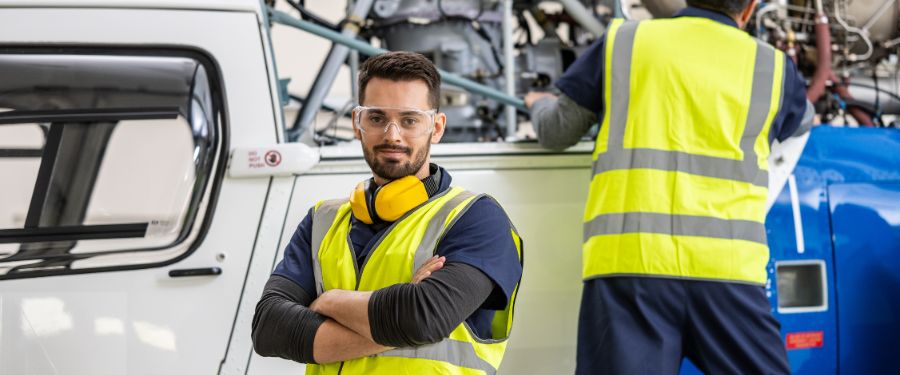In the world of civil aviation safety in Australia, a drug and alcohol management plan (DAMP) is a crucial framework designed to ensure the highest safety and security standards within the aviation industry.
With this in mind, the nation’s Civil Aviation Safety Authority (CASA) has mandated the implementation of DAMPs across organisations in the aviation industry. These plans are to consist of an organisation’s policies and procedures revolving around drug testing.
Any organisation that employs one or more persons who perform safety-sensitive aviation activities (SSAAs) must have a drug and alcohol management plan (DAMP) in place.
DAMPs should include policy developments that clearly outline the organisation’s stance against drugs, as well as repercussions for policy violations, statements of confidentiality, testing procedures, response policies, and more.
In this blog post, we’ll be exploring what makes a good drug and alcohol management plan for the aviation industry, the role of a DAMP in preventing accidents, and more.
What does a DAMP include?
According to CASA, any organisation’s DAMP must include an education program, a testing program, and a response program.
Some organisations could have a single document that covers all requirements, while others might include an overview document with links or references to other material. Each of the three mandatory programs is explained in more detail below.
Education program
A drug and alcohol education program as part of a DAMP is published in order to raise awareness among employees and stakeholders on the effects and risks of alcohol and other drugs on aviation safety, the organisation’s responsibilities, and employee responsibilities.
The education program is for employees who perform SSAAs, including staff, contractors, subcontractors, and volunteers. This section must also clearly outline the organisation’s policy on alcohol and drug use, testing in the workplace, available support services and potential risks caused by the use of drugs and alcohol
Testing program
The testing program of a DAMP outlines how tests are conducted, who can be tested, testing procedures, SSAA employee responsibilities, and more.
Anyone who performs or is able to perform an SSAA can be tested without notice or as part of employer testing. Common SSAA roles that are subject to testing include flight crew, cabin crew, ground handlers, maintenance teams, aircraft dispatchers, security staff, and anyone who works airside.
Testing for drugs and alcohol is usually done through a drug test kit, a breathalyser, or both.
As part of the Civil Aviation Safety Regulations, there are two types of alcohol and drug tests that can be done, which are non-notice or random testing, also known as CASA testing and employer testing which is part of an organisation’s DAMP.
Response program
This section of a DAMP is crucial as it must outline procedures to remove SSAA employees from duty if found to be under the influence of alcohol or other drugs until it’s safe for them to start again.
CASA outlines that organisations must stop an employee from service if any of the following happens:
- An employee tests positive for alcohol or drugs
- An employee refuses a test or interferes with a test
- A DAMP supervisor suspects on reasonable grounds that an employee is intoxicated
- An accident or serious incident happens.
The response program must also outline conditions for employees to resume SSAA duties. However, the decision to reinstate an employee after a failed drug or alcohol test is at the organisation’s discretion.
Testing for drugs and alcohol in the aviation industry
CASA’s guidelines indicate that alcohol tests can only be done through an Australian Standard AS3547 certified breathalyser. If the preliminary test is positive, a confirmatory test will be done.
If the second test shows a reading of 0.02%BAC or higher, the employee needs to be removed from their SSAA duties. If the second test is negative, the whole test will be considered negative.
Drug tests can be done using a saliva drug test kit. During the testing procedure, a trained tester will request an oral sample from the subject. During the test, any SSAA activities must be put on hold, and the employee must stay with the tester during the test.
Similar to the alcohol breath test, if the first test returns a positive, a confirmatory test will be performed. If the second test is positive, a further sample will be extracted and sent to an approved laboratory to confirm the results.
The employee in question must then stop performing or being available to perform any SSAAs until the confirmatory result is received.
All employees are within their right to refuse a test. However, refusal can result in removal from performing any SSAAs. Failure to do so could result in a criminal charge.
A comprehensive DAMP will:
- Manage the risks of alcohol and other drugs at work
- Outline an organisation’s policy on the use of drugs and alcohol
- Record how an organisation is following the rules outlined by CASA
The deterrent effect of a DAMP and other benefits
Just like any other corporate document, all employees who perform SSAAs must be able to access the DAMP before they perform or are ready to perform their duties and at all other times. However, not all organisations need a full DAMP. If a business has fewer than 10 employees who do SSAAs and aren't an air transport operator, they may be able to adopt CASA’s standard DAMP.
Ensuring that employees are aware of testing procedures can act as a deterrent against drug and alcohol use in the industry through its preventive and disciplinary measures.
DAMPs in the aviation industry, as mentioned earlier, must consist of an education program that informs employees about the risks associated with drug and alcohol use and the impact on safety. Pre-employment testing sets a clear expectation of a substance-free workplace from the outset.
Random drug testing creates uncertainty among employees about when they might be tested. This uncertainty further serves as a deterrent, discouraging substance use at the workplace.
Clearly outlined consequences of violations, such as termination or suspension also act as a strong deterrent. Other benefits of a holistic DAMP include:
- Legal compliance
- Establishing a culture of safety
- Improved health and well-being from employee assistance programs
- Enhanced productivity from a substance-free workplace
- Positive reputation through demonstrating a commitment to safety and responsibility
Andatech breathalysers and drug test kits for DAMP
Andatech offers a wide range of breathalysers and drug test kits that can help play a crucial role in enforcing a drug and alcohol management plan by providing accurate, reliable, and efficient testing solutions.
All Andatech industrial breathalysers have met the stringent certification requirements of AS3547:2019.
Andatech saliva drug test kits are non-invasive, convenient and can yield results in just 10 minutes. Andatech saliva drug test kits can detect up to eight major drug groups and alcohol through a single saliva sample. Selected drug test kits like the DrugSense DSO8 Plus and the Maxi Check 7 have been verified to AS/NZS4760:2019.






